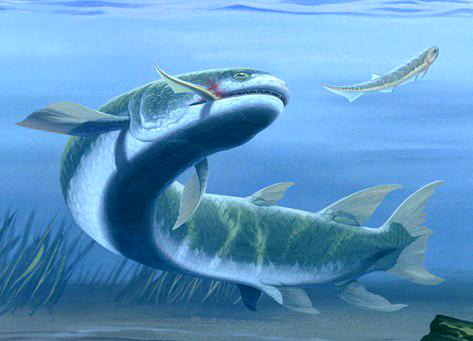Of predators and prey
The waters of the ancient Miguasha estuary were overflowing with fish, some of them predators, some prey, some both.
 (52 kb) By studying the anatomy of fish fossils, it is possible to establish which role each type of fish played in this past environment.
(52 kb) By studying the anatomy of fish fossils, it is possible to establish which role each type of fish played in this past environment.
The best evidence for determining predation is dentition: the number, kind and arrangement of teeth or tooth-like structures in vertebrates. For example, the actinopterygian Cheirolepis had many sharp teeth, the characteristic mark of a predator, as did sarcopterygians Miguashaia, Eusthenopteron, Quebecius and Holoptychius, and the elpistostegalian Elpistostege. Eusthenopteron in particular must have been one of the most fearsome of these predatory fish, with its hydrodynamic body and strong fins. The sword-like “razor blades” in the jaw of the placoderm Plourdosteus also indicate a carnivorous nature despite the absence of sharp teeth.

 (28 kb)Direct evidence of predator–prey relationships may be obtained by examining stomach contents. We know, for example, that acanthodians like Homalacanthus were the prey of large predators, such as Eusthenopteron, and that the latter would sometimes take part in cannibalistic practices, as did another actinopterygian, Cheirolepis.
(28 kb)Direct evidence of predator–prey relationships may be obtained by examining stomach contents. We know, for example, that acanthodians like Homalacanthus were the prey of large predators, such as Eusthenopteron, and that the latter would sometimes take part in cannibalistic practices, as did another actinopterygian, Cheirolepis.
Prey may also be identified by examining the contents of fossilized excrement known as coprolites. For example, the abundance of acanthodian scales and spine fragments in coprolites reveal that these little fish, the most abundant in the waters of the Miguasha paleoestuary, were the preferred food of other fish.
The growing list of known species in fossilized excrement suggests that most Miguasha fish species were, at one time or another, the prey of a larger predator. Together with the evidence from stomach contents, which indicates that the most ravenous of these fish went as far as to eat fellow creatures of the same species, one can’t help but imagine the Miguasha paleoestuary as an aquatic “Jurassic Park”!

 (52 kb) By studying the anatomy of fish fossils, it is possible to establish which role each type of fish played in this past environment.
(52 kb) By studying the anatomy of fish fossils, it is possible to establish which role each type of fish played in this past environment. The best evidence for determining predation is dentition: the number, kind and arrangement of teeth or tooth-like structures in vertebrates. For example, the actinopterygian Cheirolepis had many sharp teeth, the characteristic mark of a predator, as did sarcopterygians Miguashaia, Eusthenopteron, Quebecius and Holoptychius, and the elpistostegalian Elpistostege. Eusthenopteron in particular must have been one of the most fearsome of these predatory fish, with its hydrodynamic body and strong fins. The sword-like “razor blades” in the jaw of the placoderm Plourdosteus also indicate a carnivorous nature despite the absence of sharp teeth.

 (28 kb)Direct evidence of predator–prey relationships may be obtained by examining stomach contents. We know, for example, that acanthodians like Homalacanthus were the prey of large predators, such as Eusthenopteron, and that the latter would sometimes take part in cannibalistic practices, as did another actinopterygian, Cheirolepis.
(28 kb)Direct evidence of predator–prey relationships may be obtained by examining stomach contents. We know, for example, that acanthodians like Homalacanthus were the prey of large predators, such as Eusthenopteron, and that the latter would sometimes take part in cannibalistic practices, as did another actinopterygian, Cheirolepis. Prey may also be identified by examining the contents of fossilized excrement known as coprolites. For example, the abundance of acanthodian scales and spine fragments in coprolites reveal that these little fish, the most abundant in the waters of the Miguasha paleoestuary, were the preferred food of other fish.
The growing list of known species in fossilized excrement suggests that most Miguasha fish species were, at one time or another, the prey of a larger predator. Together with the evidence from stomach contents, which indicates that the most ravenous of these fish went as far as to eat fellow creatures of the same species, one can’t help but imagine the Miguasha paleoestuary as an aquatic “Jurassic Park”!
Site map | Feedback | Links | Sources | Credits
Of predators and prey
<< The food chain | Stomach contents >>

Title: Eusthenopteron foordi
Author: Jean-Pierre Sylvestre
Sources: Parc national de Miguasha
Year: 2003
Description:
It was during the Devonian Period that sarcopterygian fish gave rise to the first terrestrial vertebrates. Eusthenopteron foordi (shown here) was long thought to be the transitional animal between fish and tetrapods, sharing features with both, but recent discoveries have shown that the elpistostegalians are even more closely related to four-legged vertebrates.



